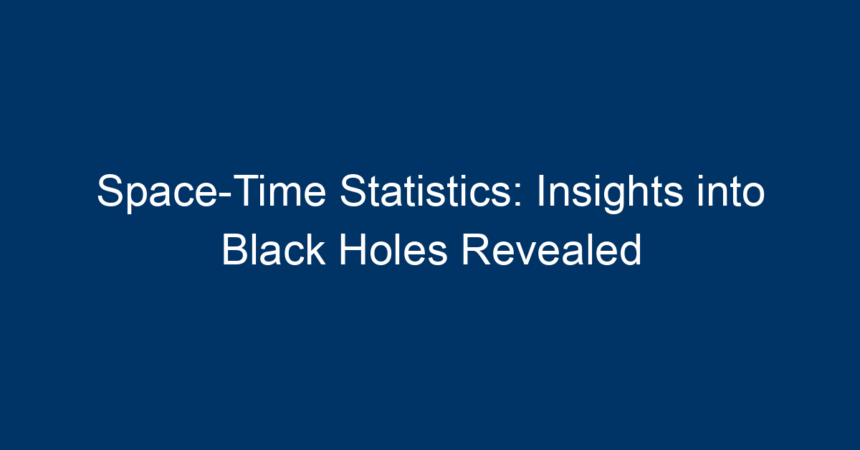The mysteries of the universe have captivated humanity for centuries, yet few subjects spark as much intrigue and curiosity as black holes. These celestial phenomena, though invisible to the naked eye, are essential to our understanding of space-time dynamics. Recent advancements in space-time statistics have provided unprecedented insights into these enigmatic entities, paving the way for breakthroughs in astrophysics. In this article, we delve into the intricate world of space-time statistics and how it illuminates the depths of black holes.
Understanding Space-Time and Its Importance in Astrophysics
What is Space-Time?
Space-time is a four-dimensional continuum that combines the three dimensions of space with the fourth dimension of time. This concept, introduced by Albert Einstein in his Theory of Relativity, revolutionized our understanding of physics. Objects in space exist not just in isolation but also in relation to time, fundamentally altering how we perceive motion, gravity, and the cosmos itself.
The Role of Space-Time Statistics
Space-time statistics refers to the use of statistical tools and methods to analyze and interpret data related to the universe’s structure and dynamics. By applying statistical techniques to vast amounts of astronomical data, researchers can uncover patterns, correlations, and anomalies, providing deeper insights into phenomena like black holes.
Key Techniques in Space-Time Statistics
-
Time Series Analysis: This involves studying data points collected over time to identify trends or cycles, essential for understanding the fluctuations in signals emitted from black holes.
-
Spatial Analysis: By examining the distribution of astronomical objects in a given space, scientists can infer the gravitational influence of black holes within galaxies.
-
Statistical Modeling: Scientists employ models to predict the behavior of black holes based on observed data, lending clarity to complex scenarios.
- Machine Learning: Artificial intelligence algorithms are increasingly used to sift through astronomical data, enhancing the accuracy of space-time statistical analyses.
Insights into Black Holes Using Space-Time Statistics
Black holes are regions in space where the gravitational pull is so intense that nothing, not even light, can escape. Although they remain invisible, their presence can be inferred through their interactions with nearby matter. Let’s explore how space-time statistics shed light on these cosmic giants:
1. Identifying Black Hole Candidates
One of the most significant uses of space-time statistics is the discovery of black hole candidates. By analyzing the movement of stars in relation to invisible mass, astronomers can identify unusual behaviors indicative of a black hole’s presence.
Case Study: The Milky Way’s Supermassive Black Hole
Astrophysicists have utilized space-time statistics to track stellar movements around Sagittarius A*, the supermassive black hole at the center of our galaxy. Observations show stars orbiting at high speeds, sinking the needle of suspicion deeper into the gravitational influence exerted by this unseen giant.
2. Understanding Black Hole Growth and Mergers
The statistics derived from gravitational wave data have transformed our understanding of how black holes grow and merge.
Measuring Black Hole Mergers
Gravitational wave detectors, like LIGO, capture the ripples in space-time caused by colliding black holes. By applying space-time statistics to this data, researchers can estimate the masses and spins of merging black holes, as well as their rates of occurrence.
This statistical approach not only validates theories of black hole formation but also reveals the overarching dynamics of the universe.
3. Investigating the Information Paradox
The information paradox continues to perplex physicists: if something falls into a black hole, does the information contained within it get destroyed? Space-time statistics plays a crucial role in addressing this enigma.
Quantum Information Theory
By employing statistical models from quantum mechanics, scientists are working to reconcile how information is preserved in the cosmos, even when matter crosses the event horizon of a black hole. This intersection between quantum theory and space-time statistics may provide groundbreaking insights into fundamental questions about reality itself.
The Future of Space-Time Statistics in Astrophysics
Advanced Observational Technologies
As observational technologies advance, the volume and precision of data will exponentially increase. Projects like the NASA’s James Webb Space Telescope are offering fresh avenues for space-time statistical analysis, enabling astronomers to test existing theories and develop new ones.
The Role of Artificial Intelligence
AI’s role in processing and interpreting astronomical data cannot be overstated. Machine learning techniques are becoming essential tools in space-time statistics, allowing researchers to uncover hidden patterns without overwhelming computational burdens.
Collaborative Research Efforts
Collaborative international research efforts, such as those in gravitational wave astronomy and cosmology, will increasingly rely on integrative space-time statistics. This holistic approach can accelerate discoveries and enhance our understanding of black holes and the universe.
Conclusion
Space-time statistics has revolutionized our approach to understanding black holes, offering insights that challenge long-held beliefs and illuminate the depths of the cosmos. From identifying black hole candidates to exploring fundamental questions in physics, this field of study is not just reshaping astrophysics; it is redefining our place in the universe.
As technology continues to advance and our understanding deepens, the future of space-time statistics promises to be both thrilling and transformative. Engaging with this rapidly evolving field is vital for anyone fascinated by the universe—be it budding astronomers, seasoned physicists, or simply curious minds. Through inquiry, collaboration, and innovation, we stand on the brink of cosmic revelations that could change our worldview forever.




